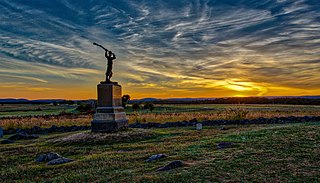
The Zouaves were a class of light infantry regiments of the French Army serving between 1830 and 1962 and linked to French North Africa; as well as some units of other countries modelled upon them. The zouaves were among the most decorated units of the French Army.

The 5th New York Infantry Regiment, also known as Duryée's Zouaves, was a volunteer infantry regiment of the Union Army during the American Civil War, led by Colonel Abram Duryée. Modeled, like other Union and Confederate infantry regiments, on the French Zouaves of Crimean War fame, its tactics and uniforms were different from those of the standard infantry.

The 69th Pennsylvania Infantry was an infantry regiment in the Union army during the American Civil War.

The 72nd Pennsylvania Infantry was a volunteer infantry regiment which served in the Union Army during the American Civil War. It was part of the famous Philadelphia Brigade.
The 6th New Jersey Infantry Regiment was regiment of infantry from New Jersey that served in the Army of the Potomac during the American Civil War.

The 62nd New York Infantry Regiment was an infantry regiment that served in the Union Army during the American Civil War. It is also known as the Anderson Zouaves.

The 4th Michigan Infantry Regiment was an infantry regiment that served in the Union Army during the American Civil War. The 4th Michigan wore a very Americanized zouave uniform. This uniform consisted of a Federal dark blue 4 button sack coat, dark blue chasseur trousers, tan gaiters, and a maroon zouave fez with a light blue tassel.

The 5th New York Veteran Infantry Regiment was an Infantry Regiment that served in the Union Army during the American Civil War. The regiment was known as "Duryée‘s Zouaves." The regiment had two uniforms during its time. The first uniform consisted of a medium blue zouave jacket with red trimming, a grey shirt, a red sash with sky blue trimming, red chasseur trousers with yellow piping, a red fez with a yellow tassel, and a white turban. The second and official uniform consisted of a dark blue zouave jacket with red trimmings in the Hawkin Zouave design, a dark blue zouave vest with red trimming, baggy red trousers, a red sash with sky blue trimming,a red fez with a yellow tassel, and a white turban.

The 44th New York Infantry Regiment was a regiment of the Union Army during the American Civil War which was formed up in mid-1861, and mustered in on August 30, 1861. The regiment wore an americanized zouave uniform which consisted of a dark blue zouave jacket with red piping on the cuffs, dark blue trousers with a red stripe, a red zouave shirt, a dark blue forage cap, and a pair of leather gaiters. The jacket had buttons down the front of it which was not part of the original French zouave uniform.

The 73rd New York Infantry Regiment was an infantry regiment of Union Army in the American Civil War. The regiment was organized in New York City in May 1861, originally under the designation the Fourth Excelsior Regiment, as a Zouave regiment, known for its unusual dress and drill style. The uniform worn by this regiment consisted of a dark blue chasseur jacket with light blue trim and light blue trefoils on each sleeve, sky blue chasseur trousers with two white stripes down each leg, brown leather gaiters, a light blue kepi with a dark blue band and dark blue piping, and a red Zouave fez with a blue tassel as a fatigue cap. Drawn from the ranks of the city's many volunteer fire companies, the unit was known alternately as the Second Fire Zouaves, after the 11th New York was known as the First Fire Zouaves, and they were also known as the Excelsior Zouaves. Some of the men wore the brass letters "E Z" on the bands of their kepis. Many artists have depicted this regiment also with red shirts with the collar sticking out over the jacket creating a "red collar."

The 140th New York Infantry Regiment was a volunteer infantry regiment that was created on September 13, 1862, for the Union Army during the American Civil War. From January 1864 they wore a Zouave uniform.

The 146th New York Infantry Regiment, nicknamed Garrard's Tigers, was a Federal regiment which mustered on October 10, 1862, and mustered out on July 16, 1865. The regiment was raised and organized in Rome, New York, and was known as the 5th Oneida Regiment. Another nickname for this unit was the Halleck's Infantry, after New York-born general Henry Halleck.

The 155th Pennsylvania Volunteer Infantry Regiment was a Federal infantry regiment that served in the American Civil War in the Army of the Potomac in the Eastern Theater of the conflict.

The 74th New York Infantry Regiment was a Union regiment recruited in 1861, during the American Civil War. The regiment was part of Sickles' Excelsior Brigade and their first commander was sailor and engineer COL Charles K. Graham.

The 72nd Pennsylvania Infantry Monument is an 1891 statuary memorial on the Gettysburg Battlefield. It is located on Cemetery Ridge, by The Angle and the copse of trees, where Union forces – including the 72nd Pennsylvania Infantry – beat back Confederate forces engaged in Pickett's Charge.
DeWitt Clinton Baxter (1829–1881) was an American artist and engraver. He also served as colonel and brevet brigadier general in the Union Army during the American Civil War.

Charles Henry Tucker "Tucky" Collis was an Irish-American US Army officer who received the Medal of Honor for his actions in the American Civil War.

The 147th Pennsylvania Volunteer Infantry was an infantry regiment that served in the Union Army during the American Civil War.
The 68th Pennsylvania Volunteer Infantry was an infantry regiment that served in the Union Army during the American Civil War.
The 27th Pennsylvania Volunteer Infantry was an infantry regiment that served in the Union Army during the American Civil War.










